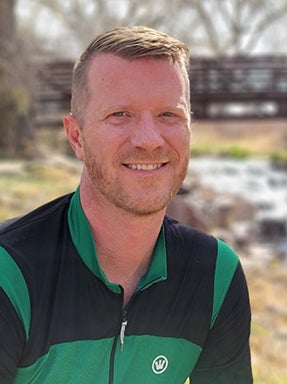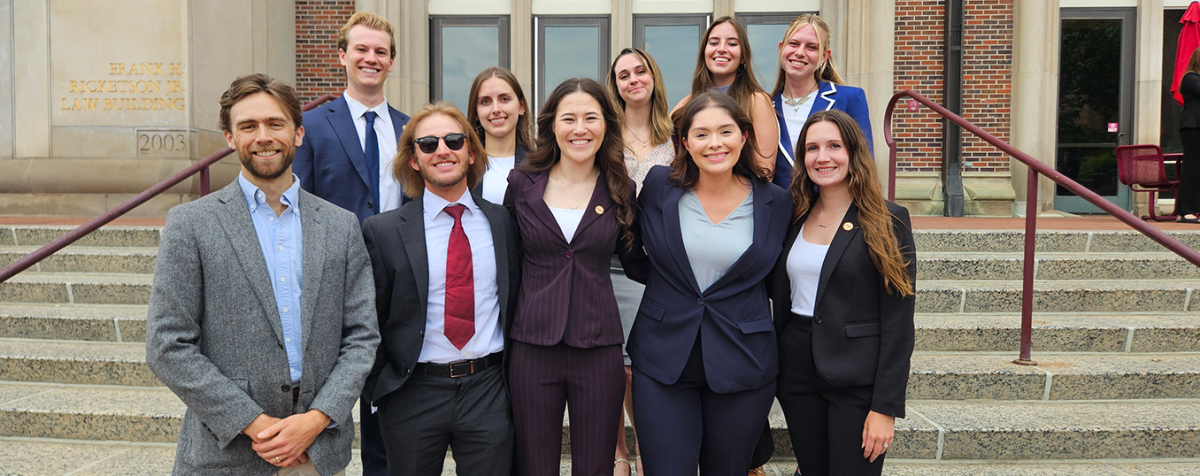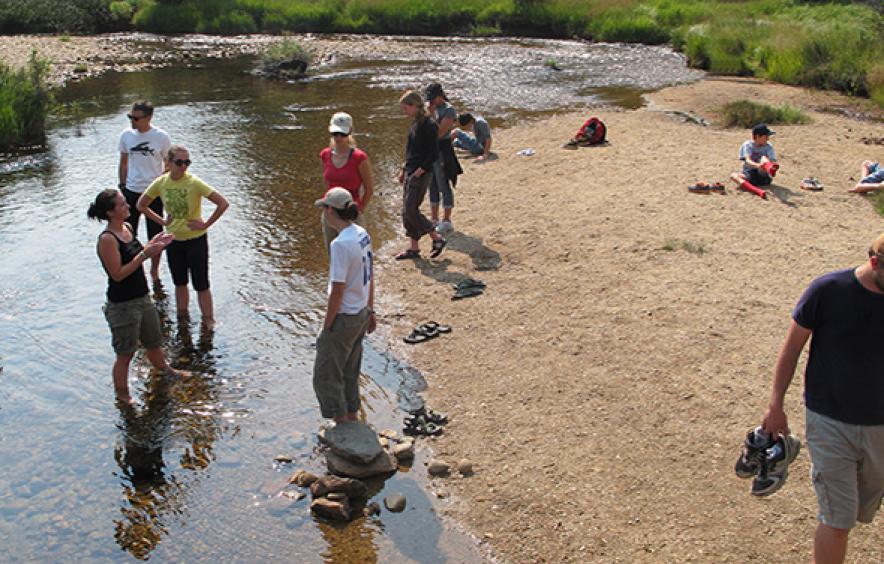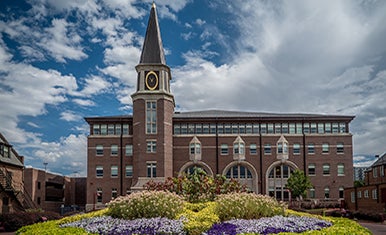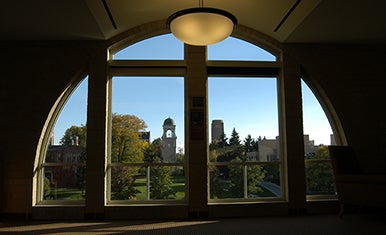Work We Do
Environmental Law Clinic Windy Gap Firming Project Settlement (April 2021)
Climate Policy & Environmental Justice: Recommendations for Colorado (Aug. 2020)
Sensitive Species Data in Colorado’s State and Local Government Decision-Making (Jan. 2020)
ENRLP Presents: Colorado Oil & Gas Conservation Commission v. Martinez - What's Next, 2/28/2019 (Thu)
Federal Wildlife Project
Saving the African Antelope | Petition to Save Exotic Birds | Returning Wolves to Rocky Mountain National Park | Handkerchief Mesa Timber Sale |
Colorado Urban Project
Addressing Public Health Risks from Coal Fire Plants | Xcels Cherokee Station | Denver Lead Safe Housing Project | Rags Over the Arkansas River v. Bureau of Land Management
Rags Over the Arkansas River v. Bureau of Land Management (D.C. Colo. 2012)
Students in the Environmental Law Clinic at the University of Denver Sturm College of Law on Feb. 1 filed suit in federal court to block “Over the River,” an industrial-scale art project by the well-known artist Christo that was approved in November by the Bureau of Land Management.
The project proposes hanging aluminum-coated material over 5.9 miles of the Arkansas River in southern Colorado, in scattered sections over a 42-mile stretch.
The suit was filed against the U.S. Bureau of Land Management (BLM) on behalf of the grassroots, all-volunteer citizen group Rags Over the Arkansas River (ROAR), whose members are dedicated to preserving and protecting the headwaters of the Arkansas River and Bighorn Sheep Canyon. The group opposes the project, citing numerous environmental issues and dangers to the residents of and visitors to the area. The suit was filed by third-year law students Mason Brown and Justine Shepherd, under the guidance of law Professor Michael Harris.
According to the suit, the project will be built almost entirely within the federally designated Arkansas Canyonlands Area of Critical Environmental Concern, key habitat for Rocky Mountain bighorn sheep, the symbol of the Colorado Division of Wildlife and Colorado’s official state animal. And the stretch of the Arkansas River running through the area is among the most popular rafting rivers in the world and is designated by the state as the most popular river for fishing in Colorado.
Federal Wildlife Project
Friends of Animals v. Kempthorne, 452 F. Supp. 2d (D.D.C. 2006).
Saving the African Antelope
In 2006 Friends of Animals, with the Environmental Law Clinic, filed suit against the U.S. Fish & Wildlife Service in U.S. District Court in Washington D.C. for violations of the Endangered Species Act and the National Environmental Policy Act. The clinic joined Friends of Animals in its fight to save three species of North African Antelope – the Scimitar-horned Oryx, Dama Gazelle, and Addax – which were imported from their native homes and brought to exotic hunting ranches in Texas. These private ranches breed the antelope in captivity and make a profit off “hunters” coming to the ranch to “hunt” and kill the antelope which are then taken as trophies. Today, the scimitar-horned oryx is extinct in the wild and very few dama gazelle and addax are found in the wild.
Contrary to the spirit of the Endangered Species Act (ESA), the Fish & Wildlife Service issued a regulatory exception for these “canned hunting” operations. Instead of using the best available science and completing a recovery plan for these listed endangered antelope, the Secretary gave these “canned hunting” operations a free pass to kill and sell these endangered species. Despite arguing that the rule actually helps the species recover in Africa, The Fish and Wildlife Service does not require canned-hunting operations to take any action to facilitate the recovery of the species into the wild either now or in the future. In June 2009, U.S. District Court Judge Henry Kennedy, in Washington D.C., ruled in favor of Friends of Animals. Currently, the clinic is defending Judge Kennedy’s ruling against appeals filed by hunting advocates (the government did not appeal) in the U.S. Court of Appeals for the District of Columbia Circuit.
Friends of Animals v. Salazar, No. 09-707 (RMC), 2009 WL 3953578, (D.D.C. Nov. 20, 2009), (complaint filed Apr. 16, 2009).
Petition to Save Exotic Birds
On January 31, 2008, the Friends of Animals petitioned the Secretary of the Interior to list fourteen species of birds as threatened or endangered under the Endangered Species Act. The species of birds Friends of Animals is trying to protect are: the Blue-headed macaw (Propyrrhura couloni); Crimson shining parrot (Prosopeia splendens); Greycheeked parakeet (Brotogeris pyrrhoptera); Hyacinth macaw (Andorhynchus hyacinthinus); Military macaw (Ara militaris); Philippine cockatoo (Cacatua haematuropygia); Red-crowned parrot (Amazona viridigenalis); Scarlet macaw (Ara macao); Thick-billed parrot (Rhynchopsitta pachyrhyncha); White cockatoo (Cacatua alba); Yellow-billed parrot (Amazona collaria); and the Yellow-crested cockatoo (Cacatua sulphurea).
A variety of man-made factors make it increasingly difficult for all of the species to continue in existence. Destruction of forests associated with changing land use practices in these species’ native ranges results in decreased habitat for many of these species. To make matters worse, each of the petitioned species is also highly sought after for sale in the caged-bird pet trade. Trappers and poachers are often either unable or unwilling to reach the birds in their nests situated high in the forest canopy, so they cut down sections of forest in order to bring the trees, nests and birds to the forest floor. Once on the ground, the chicks or fledglings are collected and sold by trappers and poachers to both legal and illegal pet markets in the United States and elsewhere. This practice increasingly harms already dwindling populations of birds and their habitats.
On April 13, 2009, the Environmental Law Clinic, representing Friends of Animals, filed a complaint in the United States District Court for the District of Columbia against the US Fish and Wildlife Service requesting the court to declare that the Secretary had violated the Endangered Species Act by not responding timely to Friends of Animals’ petition. In response to the lawsuit, the US Fish and Wildlife Service issued a finding that the listing of the birds as endangered may be warranted. The Fish & Wildlife Service, however, has not met its legal obligation to complete a 12-month review to determine whether to place these species of birds on the endangered or threatened species lists. As such, on February 15, 2010, the Clinic filed a second Complaint against Fish & Wildlife Service to compel full compliance with the Endangered Species Act.
WildEarth Guradians v. National Park Service, No. 08-cv-00608 (D. Col. 2008).
Returning Wolves to Rocky Mountain National Park
“Even without political interference, perfect naturalness is no more achievable in the national parks than perfect justice is possible in the court. But that is not the same as to say that naturalness is an invalid goal. Somewhere we must have a benchmark, a standard, a governing principle. Somewhere in all our artificial and semi-natural world of factories and automobiles and cow pastures and woodlots, we must have places where the conservation of nature is paramount.” — Thomas McNamee, Nature First.
The Environmental Law Clinic represents WildEarth Guardians in its quest to return places like Rocky Mountain National Park in Colorado to its natural, wild state, as intended by Congress. The National Park Service (“Park Service” or “NPS”) was created by Congress as a steward to protect wildlife and natural ecosystems within our nation’s park system. It is the sole agency entrusted with authority to both maintain and restore the natural conditions and processes of the parks. With regards to its adoption of a much needed Elk and Vegetation Management Plan (“the Plan”) for Rocky Mountain National Park (“RMNP” or “the Park”), the Park Service has failed in its mission in two significant ways. First, the Park Service refused to consider as an alternative the most natural of all methods to control elk populations in the Park – the reintroduction of the gray wolf. Second, the Park Service’s adopted elk management plan relies upon the most unnatural of all means – the use of “volunteer” shooters to “cull” the elk herds. On both counts, the Complaint in this case asserts that the Park Service violated the National Environmental Policy Act (“NEPA”) (42 U.S.C. § 4321, et seq.), the Park Service’s Organic Act (16 U.S.C. § 1, et seq.), and the Rocky Mountain National Park Act (“RMNP Act”) (16 U.S.C. § 198c).
Colorado Wild v. Vilsack, No. 1:09-cv-01272-JLK, 2009 WL 2491625, (D. Colo June 1, 2009).
Handkerchief Mesa Timber Sale
On June 1, 2009, the Environmental Law Clinic filed suit in US District Court for the District of Colorado, representing two environmental organizations; Colorado Wild and WildEarth Guardians, against the United States Forest Service challenging the approval of a proposed logging project in one of Colorado’s most beautiful National Forests. The proposed project would fall nearly 3,435 acres of trees. The Handkerchief Mesa, located in south-central Colorado in the Rio Grande National Forest (“RGNF”), helps form the backdrop of the San Luis Valley, one of the largest mountain basins in the world. The area is home to over 300 species of fauna and provides habitat for several threatened or endangered species, including the Mexican spotted owl, peregrine falcon, bald eagle, and Canada lynx. Rivers and streams in the area form the headwaters of the Rio Grande River, which not only support local and downstream riparian ecosystems, but also provide drinking water to millions of people throughout southern Colorado and New Mexico.
Unfortunately, for nearly 100 years, the timber industry has been allowed to clear-cut massive portions of forest in and around Handkerchief Mesa, leaving the forest ecosystem severely stressed, the soils in disarray, and regional water quality at risk.
At a time when restoration of the forest in this area should be the focus, the United States Forest Service instead proposed to once again log timber on the Handkerchief Mesa. Remarkably, the Forest Service’s own environmental review of the proposed timber sale demonstrates that the project not only unequivocally violates applicable regulatory standards, but also fails to adequately consider adverse environmental impacts as required by both the National Forest Management Act and the National Environmental Policy Act.
WildEarth Guardians v. Pub. Serv. Co. of Colo., No. 09-cv-01862-ZLW-MEH, 2009 WL 3296103, (D. Colo. Oct. 13, 2009) and WildEarth Guardians v. Lamar Utilities Board D/B/A Lamar Light And Power, and Arkansas River Power Authority, No. 09-CV-02974-DME-BMB (D. Colorado 2009)
Addressing Public Health Risks from Coal Fire Plants
On July 2, 2009, the Environmental Law Clinic filed a suit, in the US District Court of Colorado, on behalf of WildEarth Guardians against Xcel Energy for constructing a new, 750-megawatt coal-fired power plant, in Pueblo, Colorado (known as Comanche Unit 3) in violation federal law. In December 2009, the Clinic, on behalf of WildEarth Guaridans, filed suit against Lamar Utilities Board (“LUB”) and Arkansas River Power Authority (“ARPA”) for constructing the a 43-megawatt coal-fired electric generating unit in Lamar, Colorado (known as the Lamar Light and Power plant) in violation of federal law.
Both complaints assert that these utilities are prohibited from constructing or operating new coal-fired electricity plants in the absence of a final determination that the facilities will achieve a level of hazardous air pollutant emissions control that satisfies requirements of Section 112 of the Federal Clean Air Act. These violation of the Clean Air Act poses a serious threat to the health of the people and environment of Colorado. The EPA has found that coal-fired power plants emit 67 of the 188 individual air pollutants Congress listed for regulation including mercury, selenium, dioxins, arsenic, acid gases, and other heavy metals. One example of these threats is, the emission of mercury, a potent neurotoxin that is increasingly found in Colorado’s streams, rivers and lakes. When ingested, normally done through the consumption of contaminated fish, the mercury absorbs into the brain, all tissues, and if a woman is pregnant will pass to the fetus causing neurological damage to the fetal brain. The other hazardous air pollutants emitted by coal-fired power listed above have also been shown to cause serious adverse health effects, including cancer, heart disease, stroke, and neurological impairment; among these toxins, dioxin, is among the most potent carcinogens on the planet.
WildEarth Guardians v. Pub. Serv. Co. of Colo., No. 09-cv-01862-MSK-MEH, (D. Colo. Aug. 6, 2009).
Xcels Cherokee Station A Monitoring Failure
On August 6, 2009, the Environmental Law Clinic brought suit in U.S. District Court for the District of Colorado on behalf of WildEarth Guardians against Xcel Energy for violations of the Clean Air Act at Xcel’s 717-megawatt, Colorado coal-fired power plant, known as the “Cherokee Station.” The complaint alleges that Xcel is not permitted to allow or cause the emission of any pollutant into the atmosphere in excess of 20% opacity, must continuously monitor opacity, and must report any deviations from these requirements at the Cherokee power plant. Over the past five years, public records obtained by WildEarth Guardians show that Xcel has repeatedly violated these requirements. Of particular concern is the excessive and unexcused monitor downtime at Cherokee Station; meaning, over the past 5 years opacity, and potentially particulate and other emissions, have gone unmonitored and unreported for substantial periods.
The EPA considers opacity as a surrogate for assessing mass emissions and a means to assure effective particulate emissions control. Particulate matter emissions are important due to their numerous serious and adverse health effects, including increased respiratory symptoms, such as irritation of the airways, coughing, or difficulty breathing; decreased lung function; aggravated asthma; development of chronic bronchitis; irregular heartbeat; nonfatal heart attacks; and premature death in people with heart or lung disease. Xcel’s violations of the Clean Air Acts opacity, monitoring and reporting requirements pose a serious threat to public health due to their relationship with harmful particulate matter emissions.
Denver Lead Safe Housing Project
In July 2009 the Environmental Law Clinic along with Groundwork Denver proudly published the “Lead Law Enforcement Booklet: A Brief Summary of Denver Municipal Code, Colorado State Law, and Federal Law for the Prevention of Childhood Lead Poisoning in Denver, Colorado.” The booklet summarizes laws available for enforcing regulation that address residential sources of lead poisoning of children in Denver. About 100 Denver children are found with lead poisoning each year. Children are poisoned when they ingest the lead, which enters their bloodstream sometimes causing brain damage. There are about 5,000 homes in Denver’s low-income neighborhoods that pose a medium or high risk for lead poisoning. Lead poisoning is entirely preventable, giving cause for hope. The purpose of the booklet is to provide lawmakers and enforcement officials an easy-to-use resource on laws and regulations pertinent to the prevention of lead poisoning in Colorado.
Clinic students are taking the prevention of lead poisoning to the next stage by continuing to work with Groundwork Denver to get the city and state to adopt rules to end or at least curb childhood lead poisoning. Specifically, clinic students attorneys are working to insure that EPA’s recent lead renovation, repair, and painting regulation is adequately enforced in Denver and that the activities of the City’s nearly 10,000 licensed contractors are undertaken to ensure public safety when working on lead containing surfaces.
